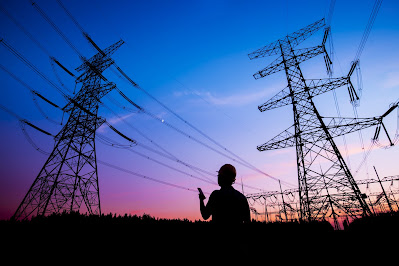Choose the correct option (2 marks each)
1. A power system will have greater flexibility of operation if they have ____
(a) Only Base load plants operating in combination
(b) Various types of power plants operating in combination*
(c) Only Peak load plants operating in combination
(d) Only thermal power plants operating in combination
(a) Only Base load plants operating in combination
(b) Various types of power plants operating in combination*
(c) Only Peak load plants operating in combination
(d) Only thermal power plants operating in combination
Hint: If various types of power plants are operated in combination, the system will become more flexible i.e Steam and Nuclear power plants will supply base loads, Hydroelectric power plants will supply base or peak loads depending upon the availability of water, Gas turbine power plant will meet peak load demand and existing Diesel power plant will operate in emergency only.
2. For a given power system, its zero and maximum regulation will occur at the impedance angle of
(a) 45*
(a) 45*
(b) 60
(c) 35
(d) 50
Hint: At θ = 45°, ZVR and maximum VR coincide.
3. A power system has a maximum load of 15 MW. Annual load factor is 50%. The reserve capacity of a plant is ____ if the plant capacity factor is 40%.
(a) 3.75 MW*
(b) 7.75 MW
(c) 46.75 MW
(d) 8.75 MW
(a) 3.75 MW*
(b) 7.75 MW
(c) 46.75 MW
(d) 8.75 MW
Hint: Load factor = (Average Demand)/ (Maximum Demand) = 0.5
Plant capacity factor = (Average Load)/ (Plant Capacity) = 0.5/0.4
Plant capacity = (0.5/0.4) × 15 = 18.75 MW
Reserve Capacity = 18.75 - 15 = 3.75 MW
Plant capacity factor = (Average Load)/ (Plant Capacity) = 0.5/0.4
Plant capacity = (0.5/0.4) × 15 = 18.75 MW
Reserve Capacity = 18.75 - 15 = 3.75 MW
4. If the power system network is at V∠δ and receiving end voltage isV∠0 consisting of the impedance of TL as (R + j5)Ω. For maximum power transfer to the load, the most appropriate value of resistance R should be ____
(a) 1.732*
(b) 3.45
(c) 5.2
(a) 1.732*
(b) 3.45
(c) 5.2
(d) 0.33
Hint: For maximum power, X=√3R = √3 x 1
5. Which of the following are the most widely used condensers in modern thermal power plants?
(a) Low level counter flow type jet condenser
(b) Parallel flow type jet condenser
(c) High level counter flow type jet condenser
(a) Low level counter flow type jet condenser
(b) Parallel flow type jet condenser
(c) High level counter flow type jet condenser
(d) Surface condensers*
Hint: Power plants mostly use surface condensers because from these condensers condensate can be used as feed water, requiring less pumping power. In case of jet condensers exhaust steam mixes with the cooling water hence condenses and cooling water are mixed so condensing cannot be recovered for the use of feed water.
6. Which of the following insulator is used for insulating stay wire from pole?
(a) Stay insulator*
(b) Pin type insulator
(a) Stay insulator*
(b) Pin type insulator
(c) Suspension insulator
(d) Shackle insulator
(d) Shackle insulator
Hint: Stay insulators are
also called as guy insulators and are used in guy cables. Because it is
necessary to insulate the lower part of the guy cable from the pole for
safety of people and animals on the ground.
7. The charging currents due to shunt admittance can be neglected, for which of the following transmission line?
(a) Long
(a) Long
(b) Short*
(c) Medium
(d) All
Hint: The shun admittance for lines more than 100 km become very prominent and can not be neglected.
8. Which of the following is like equivalent circuit of medium transmission line?
(a) RLC circuit in pie form*
(b) Series RL circuit
(c) Parallel RL circuit
(d) Series RLC circuit
(a) RLC circuit in pie form*
(b) Series RL circuit
(c) Parallel RL circuit
(d) Series RLC circuit
Hint: Medium transmission lines have considerable amount of inductance,
resistance and shunt capacitance. Medium transmission lines are
represented as either pie form or as T form.
9. Which of the following equipment or element can reduce the Ferranti effect?
(a) Circuit Breaker
(b) Current limiting reactors*
(c) Relay
(d) Resistors
(a) Circuit Breaker
(b) Current limiting reactors*
(c) Relay
(d) Resistors
Hint: For high voltage and extra high voltage lines, shunt reactors are
provided to absorb part of charging current. As leading charging current
is reduced. Ferranti effect is also reduced.
10. Power transfer capability of transmission line is mostly affected by ____
(a) Shunt conductance
(b) Capacitance
(c) Resistance
(d) Inductance*
(a) Shunt conductance
(b) Capacitance
(c) Resistance
(d) Inductance*
Hint: The power transfer in long transmission lines is limited by the
magnitude of the voltages at the two ends, the reactance between the two
ends, and the sine of the angle between the two voltages.
Steady-state stability limit is given by P = [EV/X]sinδ
---
The study material for AMIE/Junior Engineer exams is available at https://amiestudycircle.com

Comments